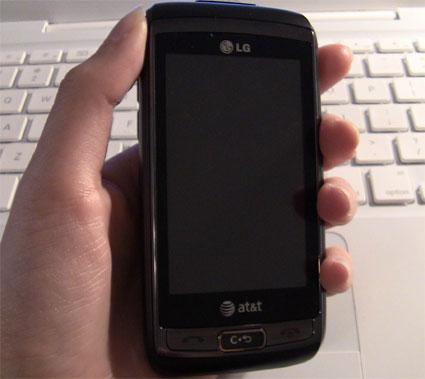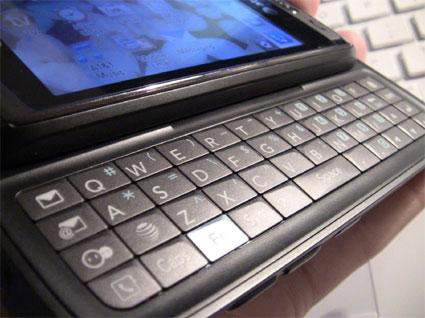The Good: 3MP camera with fun editing features; physical keyboard; shortcut keys on the the keyboard come in handy.
The Bad: Lag when scrolling through homescreens and menus; battery didn't last very long; still had a few problems with the touchscreen even though it is capacitive.
The Verdict: The LG Vu Plus has a lot to offer by way of features, but it's performance left much to be desired.

The LG Vu Plus has a lot of new features that the original Vu lacked along with a few improvements - a physical keyboard, capacitive touchscreen, and a new homescreen set up. With all of this and a 3 MP camera, it's hard to go wrong. I mean, how often do you see a capacitive touchscreen display on a featurephone? It's a solid addition to AT&T's messaging phone line-up. Does it live up to the hype?
The design of the Vu Plus is definitely one of the biggest changes from the original Vu. Besides the physical keyboard (duh) the Vu Plus has tapered ends at the top and bottom of the phone. The home key functions are the same, but they're offset in their own chrome-like textured section while the back button is a simple clear-plastic covered button in the middle. The Vu Plus is also more rounded than the squarish original Vu. On the right side of the device is the volume rocker button and the task menu button. The left side contains the microSD card slot, the screen lock/unlock button, and the camera shutter key. The microUSB charging port is on the top of the phone. The back is where you'll find the 3 megapixel camera with its LED flash.

In the box, along with the redesigned phone, you get a wall charger, a battery, an Interactive Tutorial CD, and other notes on different accessories you can buy for the phone.
Moving onto a few more technical details about the design of the phone, the main display is a 3-inch TFT capacitive touchscreen with resolution of 400 x 240. With the 3-inch screen the phone measures a total of 4.31 inches tall, 2.1 inches wide, .6 inches thick and weighs 3.95 ounces. It's a bit lighter than other messaging phones, but only in the slightest degree. The aforementioned microSD card slot will support up to 16 GB of additional memory, complimenting the phone's built-in 50 MB of memory. The battery that is shipped with the phone is a 950 mAh battery, which seemed a little underpowered to me. It turn out to be a problem.
The Vu Plus uses LG's standard featurephone UI, while taking a few queues from Samsung's TouchWiz interface. So, while you have the typical menu you see in other LG featurephones, you also have at your disposal three different homescreens, one of them dedicated to widgets. Sound familiar? Though this is a feature I've always loved about TouchWiz, LG didn't manage to copy it very well. A widget screen is nice, but you only have seven widgets available, most of which I never use. The available widgets are three different styles of a clock (one digital, one analog, and one dual), a calender, the music player, a photo frame, and a notepad. Because three of these widgets are a clock, that only leaves you with four. Do you see the problem? So I'm thinking, 'well what about the alarm clock or messaging or mobile e-mail? What if I want widgets or icons for those?' Well, those are all listed in the Shortcuts page, one of the other two pages available. Okay, so now I'm thinking, 'this is a nice feature, but since it has all the shortcuts I need, I don't really need the widgets page.' This could just be me looking at it in my own little strange way, but it seemed that there wasn't a lot of thought put into this. Regardless, those features are at your disposal.
As mentioned, the screen is a capacitive touchscreen, which, to be quite honest, surprised the heck out of me. When I realized it was capacitive, I thought 'oh cool, that's awesome because capacitive screens are generally better than resistive screens.' Well, not this one. Don't get me wrong, it was okay and it did its job, but I don't think it does the capacitive screen technology justice. A resistive screen would have performed just as well as this one did. There was also a bit of a lag when scrolling through homescreens and menus and when web browsing. That's probably due to the underpowered processor, but it is something I noticed right from the start and continued to notice each time I had to deal with it.
So, it sounds like I hate the phone, right? To be fair, the Vu Plus does have a few redeeming features. The camera, for example, is a winner. Three megapixels and a flash, plus several very cool editing features are a welcome step up from the 1.3 and 2 megapixel cameras I've been seeing lately that hardly do anything beyond taking a picture. With the Vu Plus' camera, there are options for changing the color tone, white balance, adding styles, text, and cropping the picture. I mean, it's not going to win you a photo contest or anything, but it's fun and gets the job done.The phone also captures video and supports video sharing and streaming video and is equipped with a music player. Though these are nice features, the phone does not have a 3.5 mm headphone jack so you'll have to find your own microUSB headset somewhere else.

When it comes to physical keyboards, you almost always have to put in the disclaimer that everyone feels differently about the design and just because I feel a certain way about this one, doesn't mean you'll agree with me. This is especially true, I think, with the LG Vu Plus' keyboard. I happen to prefer the grippy, tactile keys that you'll find on the Samsung Impression or Flight. I'm not too fond of keys that feel to plasticky and are set up in a grid format, which is exactly what you'll find on the Vu Plus. These are arranged in a grid and there isn't much grip to them. Not only does the lack of separation cause problems for me, but the keys are barely raised or domed meaning that my fingers easily slide around on them, which can be a problem when I'm trying to press one specific key while typing. Adding to this, the keys are too firm. This means I have to press down even harder which leaves more room for sliding around. Okay, it wasn't as horrible as I may be making it sound, but it did take some getting used to. For you, the reader, here's a test to see if this keyboard is for you. Do you like the keyboard on the Motorola Droid? If yes, you'll be fine with the Vu Plus' keyboard. If you didn't like that keyboard, you won't be okay with this one either. And that pretty much settles that.
As far as text messaging goes, the phone does feature threaded text messaging. As with most featurephones, the web browser is not the best, but you can kind of expect that. The page loaded just fine, though it may have taken longer than a smartphone would have, and scrolling works, however choppy it may be. The web browser only works in landscape mode, which is strange to say the least. Easy to get used to, I suppose, but strange nonetheless. You also have access to your e-mail accounts and Twitter, Facebook, or MySpace.

I mentioned earlier that the 950 mAh battery seemed a little underpowered and how it did end up becoming a problem. While testing the device, the battery went dead after only 2.5 days on standby. I thought maybe this was just a quark or a fluke so I charged the battery and tested it again. The same thing happened. Two-and-a-half days on standby may be okay for a smartphone, but it's not okay for a featurephone. Probably 95 percent of all the featurephones I've tested have batteries that last about 5 days on standby and 2.5 days with heavy use. I'm not sure what the problem is here, but the battery doesn't live up to expectations.
From the start, I had mixed feelings about the LG Vu Plus. It has a lot of potential and comes with great features, but it doesn't perform very well. In the end, I guess it's all about performance. The camera is great and the keyboard may be to others' liking even though it wasn't to mine, but the battery underperformed, the speed of loading programs and switching through menus was a bit slow, and I wasn't impressed with the homescreen setup and options. Not to mention the price. As of the writing of this review. the Vu Plus is going for a steep $149 with a 2-year contract and rebates. Personally, I think there are better options for messaging phones on AT&T, including the Pantech Link, which is only $10 on contract, and the Samsung Flight, which is currently free. You can't beat free, right? Especially when the free phone performed better than the expensive phone.